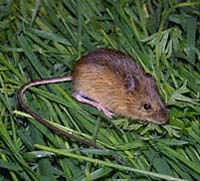Pacific bouncy mouse
| Pacific bouncy mouse | ||||||||||||
|---|---|---|---|---|---|---|---|---|---|---|---|---|

Pacific bouncy mouse ( Zapus trinotatus ) |
||||||||||||
| Systematics | ||||||||||||
|
||||||||||||
| Scientific name | ||||||||||||
| Zapus trinotatus | ||||||||||||
| Rhoads , 1895 |
The Pacific bouncy mouse ( Zapus trinotatus ) is a rodent (Rodentia) found in North America from the family of bouncy mice (Zapodidae).
features
This Pacific jumping mouse reaches a total length of 221 to 242 mm, of which the tail is 112 to 155 mm. The rear foot length varies between 30 and 36 mm, the ear length between 14 and 16 mm. The weight averages 27.5 grams. The coarse fur shows a clear separation of dorsal and ventral colors. The back is dark brown, the sides are brownish and sometimes spotted black. The color of the fur turns pale in autumn. The belly is whitish, usually slightly brownish piebald. The tail is sparsely hairy, dark brown on top and white on the underside. The back legs are much longer than the front legs.
| 1 | · | 0 | · | 1 | · | 3 | = 18 |
| 1 | · | 0 | · | 0 | · | 3 |
The dentition consists of a total of 18 teeth. It has in each half of the jaw an incisor ( incisors ), but no canine ( canine ). There is a premolar in the upper jaw and no anterior molar in the lower jaw . In each half of the jaw three molars (are Molar ) present.
distribution and habitat
The range of the species extends from the southwest of British Columbia to the middle of California . It prefers to inhabit dense forests, mountainous meadows and moist grassy areas. The populations sometimes spread strongly in rainy areas.
Way of life
The Pacific jumping mouse feeds primarily on plant seeds, as well as fruits, mushrooms and insects, which it looks for on the ground. Sometimes molluscs or fish are also accepted as food. Pacific bouncy mice move quickly and restlessly, make long jumps with their strong hind legs and land on their front paws, with the tail supporting the control and balance behavior. The mating season begins in May. Between July and August, after a gestation period of 18 to 23 days, the female throws four to eight cubs once a year, which are fully grown after around four weeks and become sexually mature in the following year. The life expectancy of the animals is up to four years. Their predators include owls and predators that are active in the evening or at night, including foxes, coyotes, snakes, weasels, skunks and bobcats.
Danger
The Pacific bouncy mouse is not yet threatened overall and is classified by the IUCN as ![]() ( least concern = not endangered). However, due to grazing of the habitat, there is already a decline.
( least concern = not endangered). However, due to grazing of the habitat, there is already a decline.
Individual evidence
- ^ A b c William L. Gannon: Zapus trinotatus , Mammalian Species, American Society of Mammalogists, No. 315, June 30, 1988, pp. 1–5 Archived copy ( memento of the original dated December 3, 2013 in the Internet Archive ) Info: The archive link was inserted automatically and has not yet been checked. Please check the original and archive link according to the instructions and then remove this notice.
- ^ IUCN Red List
Web links
- animaldiversity.org - Animal Diversity Web
- Pacific bouncy mouse (Zapus trinotatus) in the Encyclopedia of Life . Accessed August 17, 2017.